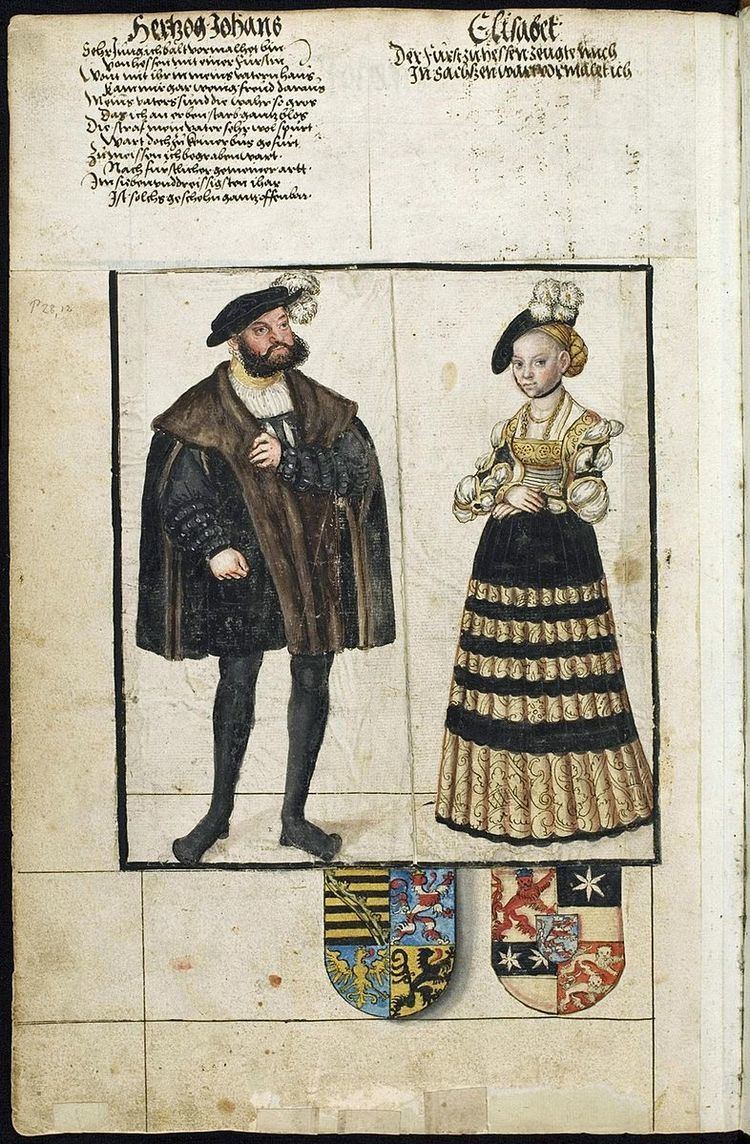Father William II of Hesse | Name Elisabeth Hesse, | |
 | ||
Born 4 March 1502
Marburg ( 1502-03-04 ) Mother Anna of Mecklenburg-Schwerin Died December 6, 1557, Schmalkalden Spouse John, Hereditary Prince of Saxony (m. 1516–1537) Parents William II, Landgrave of Hesse, Anna of Mecklenburg-Schwerin Siblings Philip I, Landgrave of Hesse Cousins Elisabeth of Hesse, Countess Palatine of Zweibrucken Grandparents Sophie of Pomerania, Duchess of Mecklenburg | ||
Elizabeth of Hesse (4 March 1502, Marburg – 6 December 1557, Schmalkalden) was a Hessian princess and by marriage Hereditary Princess of Saxony. After the death of her husband, Hereditary Prince John of Saxony, she managed her Wittum, the Saxon districts of Rochlitz and Kriebstein and other possessions, independently. This earned her the nickname "Elisabeth of Rochlitz".
Contents
Childhood and Youth
Her childhood was marked by the struggle of her mother Anna of Mecklenburg-Schwerin against the Hessian estates, who, after the death of her father, William II of Hesse in 1509, in violation of his the instructions in his testament, formed a five-member council, chaired by the steward Ludwig von Boyneburg to Lengsfeld. This Council took over the government of the territory for the Landgrave, Elizabeth's brother Philip I, and took Anna and her children under guardianship.
During that period Elizabeth lived with her mother, at her Wittum in Gießen, while her brother remained in Kassel under the supervision of Ludwig von Boyneburg to Lengsfeld.
Elizabeth and her mother were financially dependent on the Council and did not receive much money. This is evident among other things, an incident in 1512. In that year, Anna's sister Catherine married Duke Henry IV of Saxony. On this occasion, Anna wanted to introduce her daughter Elisabeth at the Saxon court, as she had been promised at a very early age to John, the eldest son of George the Bearded. Anna requested some Damask for a proper dress from the council, but the request was denied. Anna then decided not to take her daughter to Dresden, because of her "shabby clothes". As a result, Elisabeth became very down to earth and in touch with ordinary citizens.
Only in 1514 did Anna succeed in obtaining guardianship over herself and her children, as well as the regency of Hesse. Anna was given the guardianship of her children, but matter of state, she had to consult on an advisory board. Elisabeth, her brother and her mother then lived together in Kassel again.
At court in Dresden
The engagement between Elizabeth and John took place on 8 March 1515, after the Pope issued a dispensation (they were related in the fourth degree). Elizabeth still lived with her mother in Kassel. In 1516 John came to Marburg, where the nuptials took place. It was not until January 1519, that Elisabeth permanently lived at court in Dresden. The marriage took place on 7 June 1519 in Kassel.
In Dresden she constantly fought for her independence against Duke George the Bearded and his court officials.
In Dresden, they had, as was her mother, constantly fighting for their independence against Duke George the Bearded and the court officials. The ever-ailing John could not catch on with his overbearing father either. The couple had no children and the pressure at the court led Elisabeth to chronic insomnia. During this period she first showed her character and her diplomatic skills. For example, she restored the peace between her brother and her mother when her mother wanted to remarry and Philip was against. Elisabeth mediated between the two again when there was tension because of the Reformation in Hesse (her mother held the Catholic faith). During this period, she also acted as a nurse for Maurice of Saxony.
Rochlitz and Schmalkalden
When John died on 11 January 1537, Elizabeth moved to Rochlitz, a district she had received as Wittum when she married. The Saxon court, however, did not grant her her own budget, which would have put her in the same situation as her mother had been in. She managed to avoid this, with the help of her brother. She received the district of Rochlitz (this included the town of Rochlitz, Rochlitz Castle, Mittweida and Geithain) and the Kriebstein district (including Waldheim and Hartha). Consequently, she is referred to in literature often by the nickname "of Rochlitz".
Elisabeth allowed the Lutheran doctrine in her territory from 1537 onwards, while rest of Saxony, under her father in law, still adhered strictly to Catholicism. Her brother sent her in the same year the Protestant preacher Johann Schütz. During this time she was also advisor of Duke Maurice of Saxony, when he took over from his father. In Rochlitz, Elisabeth brought up Barbara, the daughter of her brother and later Countess of Württemberg-Mömpelgard.
After the defeat of the Schmalkalden League, Elisabeth had left her retirement home in Rochlitz. Her brother gave her the Hessian part of Schmalkalden as a widow seat. She lived here from 1547 at court in Hesse. Her brother fell into imperial captivity, and his wife, Christine of Saxony (1505–1549) took steps to get him released. During this time, Elizabeth was often in Kassel, in order to care for the education of Philip's children. In 1556 Elisabeth fell seriously ill, after which her brother set up the first pharmacy in the city of Schmalkalden. She died on 6 December 1557 in Schmalkalden and was buried in the St. Elisabeth's Church in Marburg. It was one of the last Landgrave burials in the St. Elisabeth's Church.
